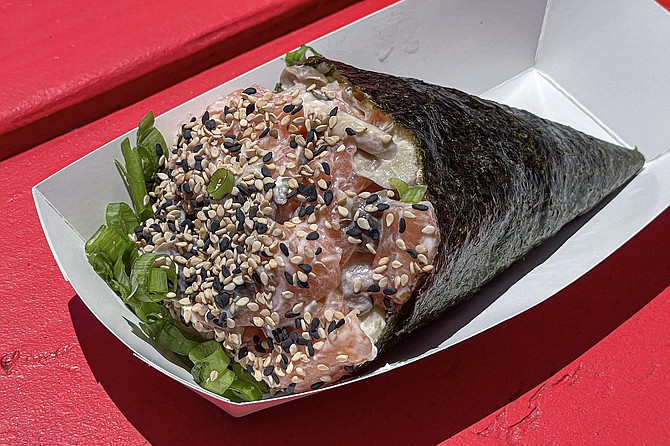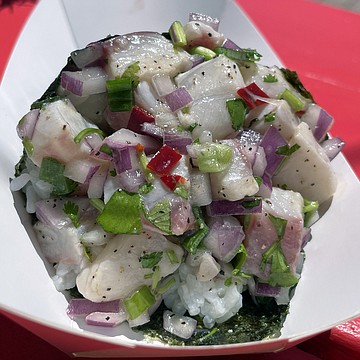 Facebook
Facebook
 X
X
 Instagram
Instagram
 TikTok
TikTok
 Youtube
Youtube

At first, $12 seems steep for a hand roll. Even at bona fide sushi restaurants, I’m used to paying somewhere in the order of 5 to 7 bucks. Conversely, this temaki is being served out of a small trailer perched along on the side of the road leading into Pacific Beach. By a couple of Brazilian dudes, no less. But in a surprising way, that’s why the higher price makes sense.
Because in Brazil, one of them explains to me, they like their food served in larger portions than you tend to find at Japanese restaurants. So at this little, makeshift eatery, dubbed Temakeria, each conical serving of rice wrapped in seaweed get stuffed with about a half pound of fish. I don’t know how much weight they pack into the little temaki at sushi restaurants, but it’s considerably less.
By comparison, these hand rolls are massive, each one nearly as substantial as a good-sized burger. I wind up ordering a two temaki combo for $22, and it winds up being more filling than two-item bento box I ordered last week.

I’ve eaten at Brazilian-infused sushi spots before, and they typically look for ways to incorporate the likes of mango or heart of palm into their maki rolls. That’s not the case here. Most of these hew closer to traditional Japanese rolls, featuring salmon, ahi tuna, or shrimp ($12 apiece). For $12.50, you may hedge your bets and order a roll of both salmon and shrimp.
On one of the owners’ recommendation, I start with the business’s most popular order: a salmon and shimeji roll (also $12.50, a la carte). Shimeji is an East Asian fungi with thin stalks and small caps that grow in clusters resembling stubby enokis. The chopped and sautéed mushrooms supplement the raw salmon, lending more complex flavor and texture to the large sushi cone, which is finished with generous sprinklings of green onions and sesame seeds.
For 50 cents extra, I “make it creamy,” which means they add cream cheese — and not the thick shmear that cuts through many a sushi roll, but fully blended in wit the mix of mushroom and fish. I’ve no choice but to call the whole assmblage a winning combination, and worth noting there’s also a roll featuring just the shimeji, to accommodate vegans ($11).

Anyone determined to experience more visceral South American influence in their Temakeria roll should look to the ceviche hand roll. This unique creation gets stuffed with something you wouldn’t expect to find at Japanese sushi joints: lime-cured tilapia.
I tend to prefer sashimi to ceviche, and just about any other kind of white fish to tilapia, but curiosity compels me to try this this tangy, citric rendition of a hand roll, punched up by. black pepper and red onions. I leave with no regrets. Most other Temakeria customers must feel the same way, because it’s apparently the second most popular order.
Six days a week, this overachieving mobile kitchen holds down a fixed location, at 1954 Balboa Avenue. It’s a short, narrow strip of real estate, nevertheless well-appointed with a bevy of picnic tables and patio umbrellas. Open noon til 9pm, Wednesday thru Monday.


At first, $12 seems steep for a hand roll. Even at bona fide sushi restaurants, I’m used to paying somewhere in the order of 5 to 7 bucks. Conversely, this temaki is being served out of a small trailer perched along on the side of the road leading into Pacific Beach. By a couple of Brazilian dudes, no less. But in a surprising way, that’s why the higher price makes sense.
Because in Brazil, one of them explains to me, they like their food served in larger portions than you tend to find at Japanese restaurants. So at this little, makeshift eatery, dubbed Temakeria, each conical serving of rice wrapped in seaweed get stuffed with about a half pound of fish. I don’t know how much weight they pack into the little temaki at sushi restaurants, but it’s considerably less.
By comparison, these hand rolls are massive, each one nearly as substantial as a good-sized burger. I wind up ordering a two temaki combo for $22, and it winds up being more filling than two-item bento box I ordered last week.

I’ve eaten at Brazilian-infused sushi spots before, and they typically look for ways to incorporate the likes of mango or heart of palm into their maki rolls. That’s not the case here. Most of these hew closer to traditional Japanese rolls, featuring salmon, ahi tuna, or shrimp ($12 apiece). For $12.50, you may hedge your bets and order a roll of both salmon and shrimp.
On one of the owners’ recommendation, I start with the business’s most popular order: a salmon and shimeji roll (also $12.50, a la carte). Shimeji is an East Asian fungi with thin stalks and small caps that grow in clusters resembling stubby enokis. The chopped and sautéed mushrooms supplement the raw salmon, lending more complex flavor and texture to the large sushi cone, which is finished with generous sprinklings of green onions and sesame seeds.
For 50 cents extra, I “make it creamy,” which means they add cream cheese — and not the thick shmear that cuts through many a sushi roll, but fully blended in wit the mix of mushroom and fish. I’ve no choice but to call the whole assmblage a winning combination, and worth noting there’s also a roll featuring just the shimeji, to accommodate vegans ($11).

Anyone determined to experience more visceral South American influence in their Temakeria roll should look to the ceviche hand roll. This unique creation gets stuffed with something you wouldn’t expect to find at Japanese sushi joints: lime-cured tilapia.
I tend to prefer sashimi to ceviche, and just about any other kind of white fish to tilapia, but curiosity compels me to try this this tangy, citric rendition of a hand roll, punched up by. black pepper and red onions. I leave with no regrets. Most other Temakeria customers must feel the same way, because it’s apparently the second most popular order.
Six days a week, this overachieving mobile kitchen holds down a fixed location, at 1954 Balboa Avenue. It’s a short, narrow strip of real estate, nevertheless well-appointed with a bevy of picnic tables and patio umbrellas. Open noon til 9pm, Wednesday thru Monday.
Comments